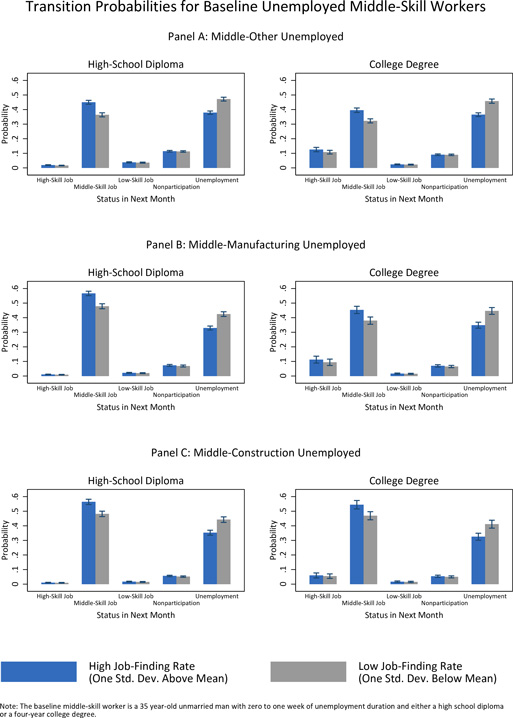2014 Series • No. 14–16
Research Department Working Papers
Labor Market Polarization Over the Business Cycle 
One of the most important long-run trends in the U.S. labor market is polarization, defined as the relative growth of employment in high-skill jobs (such as management and technical positions) and low-skill jobs (such as food-service and janitorial work) amid the concurrent decline in middle-skill jobs (such as clerical, construction, manufacturing, and retail occupations). Middle-skill job losses typically result from outsourcing labor to lower-wage countries or from substituting automated technologies for routine tasks. Economists are now beginning to study how long-run polarization might be related to short-run business cycles, but doing so requires the construction of quarterly datasets with consistent occupational data over long periods of time. The authors of this paper construct a new dataset of occupational employment and unemployment that extends from 1947:Q3 to 2013:Q4. Using this dataset, along with more-recent individual-level data from the Current Population Survey, the authors study how recessions typically affect employment in various occupations, what employment alternatives are available to middle-skill workers who become unemployed, and whether the ongoing erosion of middle-skill job opportunities is related to long-term declines in labor force participation among men.

 Key Findings
Key Findings
- Throughout the postwar era, the cyclicality of employment for middle-skill workers engaged in routine manual tasks like assembly-line work has been high yet stable. The main reason is probably that the majority of these individuals work in construction and manufacturing, and in employment in these industries varies over the course of the business cycle. For middle-skill workers engaged in sales and clerical positions, which are categorized as routine cognitive work, employment has become increasingly sensitive to the business cycle over time, as has employment among high-skill workers.
- Middle-skill workers who lack college degrees rarely exit unemployment by taking high-skill or low-skill jobs. It is quite likely that if these unemployed middle-skill workers do not return to middle-skill occupations, they will drop out of the labor force.
- Falling demand for middle-skill jobs appears to account for much of the overall decline in labor force participation among men since the 1970s. This finding indicates that occupational polarization is related to the drop in male labor force participation.

 Exhibits
Exhibits


 Implications
Implications
The authors' results suggest that middle-skill employment is very sensitive to the business cycle, in large part because of the disproportionate number of middle-skill workers employed in manufacturing and construction, two very cyclical industries. Most formal models of the business cycle, however, omit such "industry effects." Additionally, the relationship between polarization and nonparticipation suggests that understanding what middle-skill workers do when they temporarily or permanently exit the labor market should be an important goal of future research on the business cycle, as answering this ??question will better explain why so many middle-skill workers exit employment during recessions.

 Abstract
Abstract
Job losses during the Great Recession were concentrated among middle-skill workers, the same group that over the long run has suffered the most from automation and international trade. How might long-run occupational polarization be related to cyclical changes in middle-skill employment? We find that middle-skill occupations have traditionally been more cyclical than other occupations, in part because of the volatile industries that tend to employ middle-skill workers. Unemployed middle-skill workers also appear to have few attractive or feasible employment alternatives outside of their skill class, and the drop in male participation rates during the past several decades can be explained in part by an erosion of middle-skill job opportunities. Taken together, these results imply that a formal labor market model relating polarization to middle-skill employment fluctuations should include industry-level employment effects and a labor force participation margin as well as pure job-search considerations. The results thus provide encouragement for a growing literature that integrates "macro- labor" search models with "macro-macro" models featuring differential industry cyclicalities and convex preferences over consumption and leisure.



